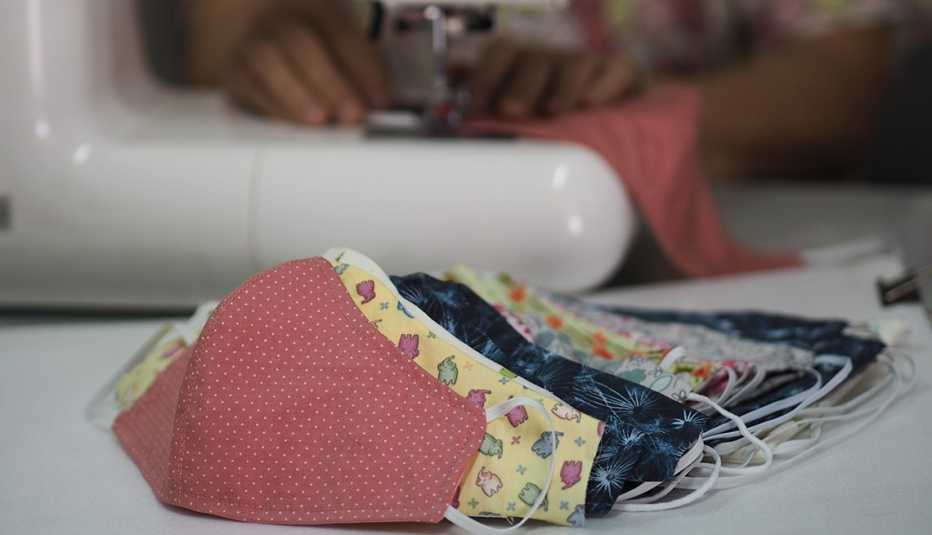Staying Fit


In Austin, Texas, crafter Sarah James has been sewing face masks as quickly as she can turn them out.
She's supposed to be furloughed from her hotel job next week. It will give her time to sew — something that feels tangible in a time of uncertainty.


AARP Membership— $12 for your first year when you sign up for Automatic Renewal
Get instant access to members-only products and hundreds of discounts, a free second membership, and a subscription to AARP the Magazine.
"I just ordered a whole bunch more fabric,” she says. “So, hopefully I'll be doing this all day next week."
Just as the Centers for Disease Control and Prevention has advised all Americans to wear nonmedical cloth masks in public, crafters around the world are trading tutorials over YouTube and patterns online.
"There was a line going around about how everyone who sews has a stash [of fabric], and she's convinced that her stash will save the world,” says Karen Dunnam, a crafter in Grand Rapids, Michigan. “And this week, she's become correct."
DIY Face Masks
Crafters are sharing a variety of patterns and instructional lessons online, from a DIY cloth face mask on Instructibles.com to a step-by-step tutorial on YouTube.
The supplies you need:
• Tightly woven cotton or cotton-poly blend fabric (you can get eight to 10 masks out of a yard) and chiffon (see sidebar)
• A needle and thread (but preferably a sewing machine)
• Sharp scissors
• Pins to hold fabric in place
• Strips of cotton fabric ties, elastic or new shoelaces for ties
• Optional: Pipe cleaners can work to help shape fabric over the nose
Mask-making essentials
In addition to sharp scissors, a sewing machine and a pattern, it's essential to find the right material if you are making a mask at home, James says.
"The number one thing we're hearing requests for is 100 percent cotton or tightly woven cotton-poly blend,” she says. “It has to be something that can be washed on high heat or sterilized in equipment that hospitals have."
Some sewing supplies have been hard to come by during the COVID crisis.
Heather Klette, a nurse in Cincinnati who is making masks at home for family members, couldn't find elastic. She found a design that uses hair ties instead. For basic masks that aren't medical-grade, James has been using pipe cleaners to make the bend over the nose.
At Barksdale Air Force Base in northwest Louisiana, military wife Amber Seigler is making 40 masks a week. She is planning to drop 20 off at a nursing home.
Best Face Mask Materials: Cotton With Chiffon
Pull out that sewing machine. A new study published in the scientific journal ACS Nano found that homemade face masks that use a combination of tightly woven cotton and polyester-spandex chiffon or silk will provide a very effective filter for the aerosol particles that spread the COVID-19 virus. Masks made with one layer of cotton and two layers of chiffon (a netlike fabric often found in evening gowns) or silk will filter out some 80 to 99 percent of particles — similar to the effectiveness of the N95 mask material — due to the electrostatic barrier of the fabric. But here’s the kicker: The mask must have a snug fit. Even a 1 percent gap reduces the filtering of all face masks by 50 percent or more.
"For me, it's just being a part of giving back,” Seigler says. “Most of the people in those situations are putting their lives at more risk than I ever will just being at home making a mask. And so, it's just to give back."
A tiny contribution
Surgical masks have to be made to a certain standard, but rules aren't as clear on what nonmedical-grade mask design is best for the masses. No matter the pattern, making these cuts of cloth is giving many people a sense of purpose in a trying time.
"It makes me feel that I can make a very tiny contribution, since I'm really a nonessential worker, to this thing that's overtaken our world,” says Adriana Binaku, owner of the Makery, a custom sewing studio in Holland, Michigan.
She says her sense of community is driving her desire to get masks to her neighbors and the elderly.
"I think it's just amazing how our country has banded together on a very grassroots, individual level,” Binaku says. “There are literally people doing this all over the country. And I just think it's, obviously, very, very sad, but kind of very amazing what's been able to be accomplished. I think that as awful as this is, and trust me, I'm a small business that is getting crushed, and I do mean crushed, I really think there's going to be a silver lining at the end of this. We've got to walk through some pain, but I think a lot of really good things are happening."

































































More From AARP
How to Stay Safe at the Grocery Store During Coronavirus Outbreak
Need to run errands? Experts say planning and handwashing are importantHow to Find Coronavirus Help in Your State
Where to go for local public health updates, food assistance and more